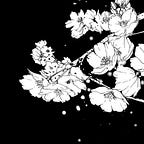Let the ideas bloom.
Finally, after weeks and weeks structuring, analysing and investigating the problem, we got to the ideation stage.
To start this part and to put us on creative mode, the teacher prepared a presentation on design projects, many super innovative and futuristic, some one might even call them crazy. And after that, she gave us instructions on some tools to use to facilitate this process.
She presented two tools: the Biomimicry Toolbox and the Lotus Flower. The first one, to put it simply, used biomimicry as a form of inspiration, to see how nature has already solved the problem and check if we can emulate in some way or form what nature does. The second one consisted of a focused brainstorm on a specific canvas. We had to choose one to work with and the team saw that the Lotus Flower offered us more diversity and set the mood better.
This tool works with a central idea, in our case the problem, and from there it derives into 8 sub-ideas which then derive into another 8 ideas each. In total, you get 64 ideas around a central problem.
To summarize our experience with the tool, at first, we started with some pretty simple and boring ideas. Bit by bit, we loosened up a little and better ideas came to be, this was around the middle of the excercise. Close to the end, continuing with the same tone, the ideas got weirder and weirder until they were almost crazy-like.
Fortunately for us, we got to present our excercise in front of the class and the teacher and got very useful feedback, not only about which ones were our better ideas, but also got some more ideas from our classmates.
At this point, I thought we were going to choose some and start the exploration part through sketches or something, but no. We moved on to another tool of ideation, this one more grounded onto the reality.
This new tool was called SCAMPER, which standed for Substitute, Combine, Adapt, Modify, Purpose, Eliminate and Reorganize. This tool works by asking you to choose a starting point to edit as you go, so you have to work with something that has already been made or that already exists, for this, we chose our sucessful case: the Fold&Float from Istanbul.
Once selected our starting point, we created a table, in which each member of the team could put their ideas about the action it corresponded to do in each section. One of the rules in this, as the teacher instructed, was to not judge the ideas of others and just let them speak their mind.
So we started and, sooner than later, we found out that this excercise was way harder for us than the Lotus Flower, we could not even begin to imagine what we would change of the ever useful Fold&Float, so this hindered a little bit the process and it was not as fun as the previous one.
Ultimately we finished the table and filled it with our ideas, and the next step was to sketch some of them, each of us was to sketch some of their ideas or even mashup more than one and sketch it. The ultimate goal was to finish with as many sketches as members of the team were.
On the learning notes, as always, it was useful getting to know the tools and trying more ways of tapping into the creative mode of the design process. It was very refreshing to do things in another way, in comparisson to using the traditional only-sketching-to-death way as always.
Truthfully, this was the most “stereotipically” creative week so far and we learned more and more tools that were useful (some more than others), we progressed in the project, each day closer to the final solution, and, personally, I also noticed that the scamper could have been more useful if the base idea on which to improve where more improvable. Not to say that the Fold&Float is perfect, but to us, it definitely felt like it covered and summarized very well what was needed in their problem and also what we needed in ours, so maybe if we were more critical of it, the excersice would have gone better.
